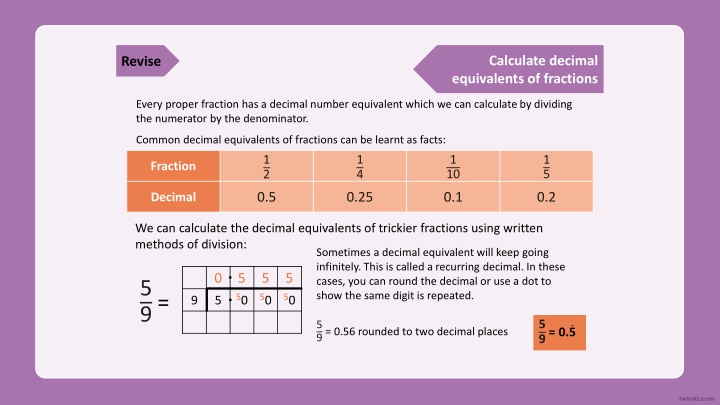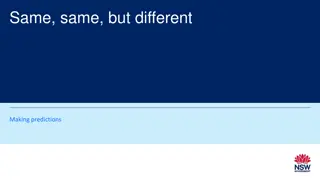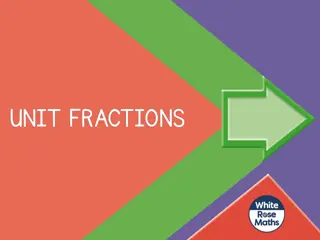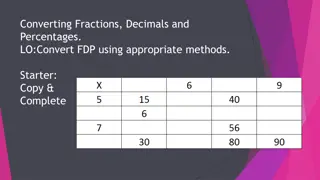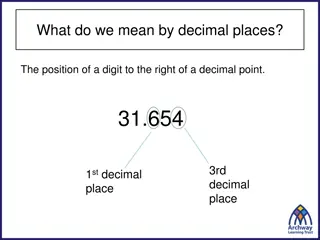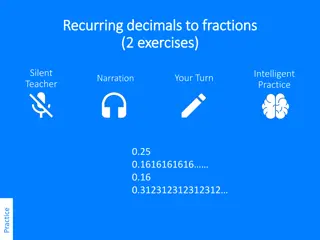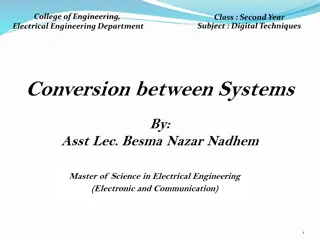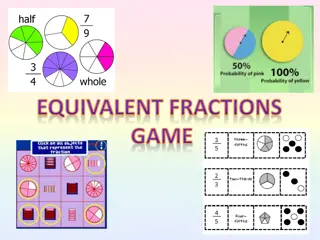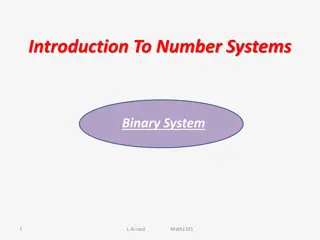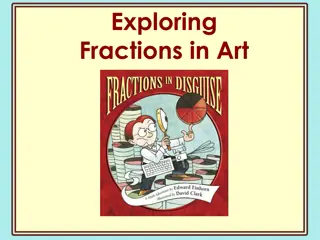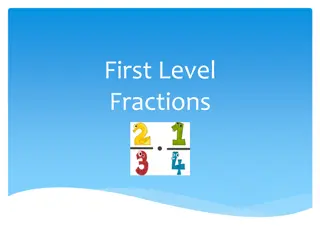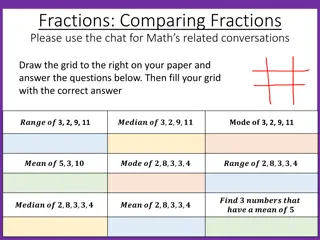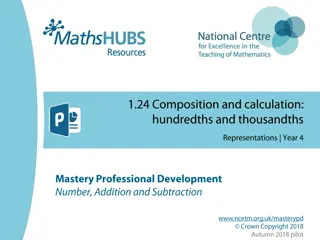Decimal Equivalents of Fractions Calculation
Learn how to calculate decimal equivalents of fractions, including common decimal equivalents and methods for trickier fractions. Practice identifying the values of digits in numbers to three decimal places, and master ordering and comparing numbers with up to three decimal places.
Uploaded on Mar 06, 2025 | 0 Views
Download Presentation

Please find below an Image/Link to download the presentation.
The content on the website is provided AS IS for your information and personal use only. It may not be sold, licensed, or shared on other websites without obtaining consent from the author.If you encounter any issues during the download, it is possible that the publisher has removed the file from their server.
You are allowed to download the files provided on this website for personal or commercial use, subject to the condition that they are used lawfully. All files are the property of their respective owners.
The content on the website is provided AS IS for your information and personal use only. It may not be sold, licensed, or shared on other websites without obtaining consent from the author.
E N D
Presentation Transcript
Calculate decimal equivalents of fractions Revise Every proper fraction has a decimal number equivalent which we can calculate by dividing the numerator by the denominator. Common decimal equivalents of fractions can be learnt as facts: 1 10 1 5 1 4 1 2 Fraction 0.5 0.25 0.1 0.2 Decimal We can calculate the decimal equivalents of trickier fractions using written methods of division: Sometimes a decimal equivalent will keep going infinitely. This is called a recurring decimal. In these cases, you can round the decimal or use a dot to show the same digit is repeated. 0 5 5 5 5 9 = 50 50 50 9 5 5 9 = 0. 5 5 9 = 0.56 rounded to two decimal places
Quiz Calculate decimal equivalents of fractions What is the decimal equivalent of this fraction? 3 8 0.25 0.375 0.125 Try again! Correct!
Quiz Calculate decimal equivalents of fractions What is the decimal equivalent of this fraction rounded to two decimal places? 2 7 0.29 0.28 0.27 Try again! Correct!
Identify the value of each digit in numbers to three decimal places Revise In order to be able to read, write and calculate with decimal numbers, we need to understand the place value of each digit after the decimal point. As the place value position moves right of the decimal point, the digits become ten times smaller. ones tenths hundredths thousandths
Identify the value of each digit in numbers to three decimal places Quiz What is the value of the underlined digit? 13.508 5 10 5 5 1000 100 Try again! Correct!
Identify the value of each digit in numbers to three decimal places Quiz What is the value of the underlined digit? 529.078 8 10 8 8 100 1000 Try again! Correct!
Order and compare numbers with up to three decimal places Revise To order decimal numbers, we compare the place value of the digits in each number, starting with the digits in the largest place value position. If numbers have the same digit in a place value position, we look at the digits in the place value position to the right until we find a difference. When comparing numbers, we can use symbols to show which is the smaller or larger number. < > is less than is greater than 0.873 > 0.853 0.205 < 0.215
Order and compare numbers with up to three decimal places Quiz Choose the correct symbol to compare these decimal numbers. 0.436 0.416 > < Try again! Correct!
Order and compare numbers with up to three decimal places Quiz Choose the correct symbol to compare these decimal numbers. 0.013 0.103 > < Try again! Correct!
Order and compare numbers with up to three decimal places Quiz Choose the correct symbol to compare these decimal numbers. 1024.663 1024.673 > < Try again! Correct!
Multiply one-digit numbers with up to two decimal places by whole numbers Revise Short Multiplication We use short multiplication when we are multiplying a decimal number by a one-digit number. Position the decimal number above the one-digit number. Make sure that the place value columns are correct. Starting at the right-hand side, multiply each digit in the decimal number by the one-digit number. 4 3 5 We can only write a single digit in each column, so if the product is a two-digit number, we have to regroup the number and place into the next column. We do this by writing the number above the digits in the next place holder. 5 9 8 3 6 4 2 4 When we regroup, we must remember to add this number to the multiplication answer of the next digit. Make sure you give your answer as a decimal.
Multiply one-digit numbers with up to two decimal places by whole numbers Revise Long Multiplication We can use long multiplication when we are multiplying a decimal number by a two-digit number or larger. Position the decimal number above the two-digit number. Make sure that the place value columns are correct. 2 2 4 1 7 6 3 8 2 4 2 8 Starting at the right-hand side, multiply each digit in the decimal number by the ones digit, regrouping and placing into the next column if necessary. Strike the regrouped numbers once you have your first answer so that you don t confuse any new regroupings. 3 4 6 4 0 8 0 8 2 1 2 6 Place a zero in the furthest right-hand column on the next row down to show we are now going to multiply by a power of ten. 1 1 Starting at the right-hand side multiply each digit in the decimal number by the tens digit, regrouping and placing into the next column if necessary. Finally, add the digits in each column using column addition to find the answer.
Multiply one-digit numbers with up to two decimal places by whole numbers Quiz What is the answer to this decimal multiplication? 5.47 2 10.94 10.82 10.814 Try again! Correct!
Multiply one-digit numbers with up to two decimal places by whole numbers Quiz What is the answer to this decimal multiplication? 7.08 15 135.04 105.102 106.2 Try again! Correct!
Use written division methods in cases where the answer has up to two decimal places Revise Short Division We can use short division when we are dividing a decimal number by a one- digit number. 1 3 2 5 Start by dividing the first digit of the dividend (the number that is being divided: 53) by the divisor (the number which is being divided into: 4). 13 10 20 4 5 Write the answer above the horizontal line and regroup any remainder to the next digit. Remember to keep the decimal place in the same place value position.
Use written division methods in cases where the answer has up to two decimal places Revise Long Division We can use long division when we are dividing a decimal number by a two-digit number or larger. Start by dividing the first two digits of the dividend by the divisor. Write the answer above the dividend and the multiple of the divisor below. Use column subtraction to calculate the remainder and draw down the next digit of the dividend. Repeat this process until the end of the calculation. Remember to keep the decimal place in the same place value position. Sometimes the answer to a decimal division may continue into many decimal places.
